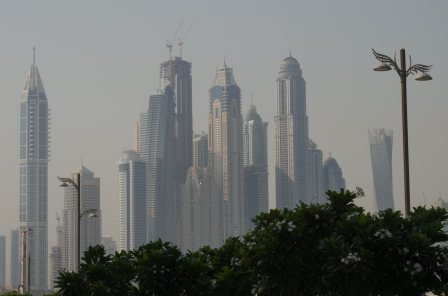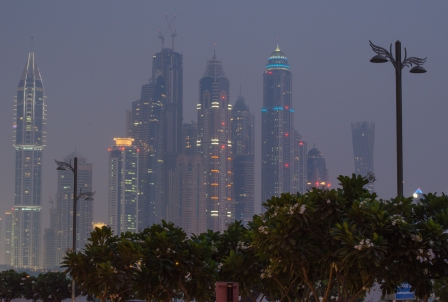Light through the day
Introduction
Präkel (2007, p57) notes that throughout the day, the colour and quality of light changes, as does the angle and direction of light. These factors are dependent on the position of the sun.
This exercise looks the way that the sun moves throughout the day and the subsequent effect this has on the quality of light.
The instructions are as follows;
- Shoot on a sunny day
- Find a landscape location with a definite subject that will catch the sunlight
- The location should be convenient to reach as you will have to return to the same spot
- Photograph the scene from sunrise to sunset taking at least one photograph per hour, keeping the composition constant.
- Use a tripod and cable release to allow you to set up the composition and then concentrate on the lighting.
I had several scenes in mind for this exercise, however as the outdoor temperatures in Dubai are still above 40°C I opted for a viewpoint close to home, where I could escape the heat and humidity. The scene looks from the Palm Jumeirah across to the skyscrapers of Dubai Marina. While scouting out the scene I noted that the sun strikes the towers from different angles during the day.
Sunrise was to be at just after 6am so I arrived a little early and set the camera upon a tripod and attached the cable release. I then composed the photograph and waited for the sun to make its appearance. All photographs were taken with a 55mm-300mm telephoto lens, an aperture of f/22 and in Manual mode. I kept the WB setting on daylight unless otherwise mentioned and adjusted the ISO throughout the day.
06:00am
Präkel (2007, p61) notes that just before the sun rises, the light is richly red towards the sun and a violet-blue away from it. This can be seen to some extent in the first photograph, which shows the buildings and sky bathed in blue light. Präkel continues, by noting that the light from the rising sun is pink just before it rises and then becomes a golden-yellow as the sun breaks over the horizon. This is evident in the 06:22am as the light hits the buildings on their left hand side and they take on a pink/orange glow. Präkel (2007, p21) notes that the typical colour temperature of light at sunrise is 3100K.
I found it extremely interesting to note the rate at which the light changed at this time of day, moving from blue to pink/orange over the space of just 16 minutes and also to note the effect this had on the recommended shutter speed.
07:00am-10:30am
At 07:23am the light is becoming paler and leaning more towards yellow. From here until 10:32am the atmospheric haze caused by heat and humidity that is prevalent in Dubai throughout the summer months descends and changes the light again to a blue colour. The rising sun casts some shadows on the central tower and on the tallest tower on the right hand side of the frame. As the sun gets higher we can see these shadows decrease then eventually disappear.
Präkel (2007, p21) notes that the typical colour temperature of light at 2 hours after sunrise is 4000K, higher than sunrise at 3100K. This is interesting, as the colour of light in the image at 08:27am could be perceived, through colour associations, to be cooler.
11:30am-14:30pm
This is when the sky is at its highest point in the sky and temperatures are at their peak. Freeman (2009, p68) notes that the middle of the day is a time that many photographers consider to have the least appealing light. Although, he does note that it can produce crisp clear images with clearly defined shapes and bright colours, particularly when the air is clear. Unfortunately this was not the case here. The atmospheric haze was thick which has made the light appear grey/white. The high sun has meant that there are no discernible shadows or highlights making the images appear very flat. Präkel (2007, p21) describes noon light as white daylight, which has a higher colour temperature than sunrise, measuring 5500K.
15:30pm-16:30pm
At 15:30pm the in-camera exposure meter still suggested a 1/90s shutter speed, however I can now see the light becoming a little more yellow as the sun hits the front of the buildings. This has increased by 16:35pm and has become more orange. The left hand side of the buildings are now in shadow. The angle of the sun has also illuminated more of the foliage in the foreground than in previous photographs
Inconveniently, a delivery truck had parked in front of the scene at this time and showed no signs of moving soon as the workers began unloading and assembling furniture. I decided to continue with the exercise.
The light is now more of a peachy/orange tone and it can be seen clearly striking the front side of the towers. In doing so, it leaves the leaves one side in shade and this help to reveal the form of the towers. The lamppost on the right hand side of the frame was shown as a silhouette in previous shots but now the angle of the light has help to reveal some of it’s form too. The colour temperature of light an hour prior to sunset measures approximately 3800K, cooler than the white light of midday.
Sunset and beyond
The sunset was due to occur at 18:38pm and as the light was fading quickly I upped the ISO to 400. However even though I was aware of the failing light I was still surprised to see how dark this scene looks in the 18:28pm photograph. I recall the scene appearing much lighter, possibly as my eyes were becoming accustomed to the available light?
As the sun is disappearing, the light appears very blue. This is because the blue and violet wavelengths of light are shorter at this time and get scattered more widely away from the sun. http://www.sciencedaily.com/releases/2007/11/071108135522.htm
By 18:50pm the light levels were very low so I opened the camera flash and adjusted the WB to flash. Even in doing so, the camera still required a shutter speed of 1.5s. The flash WB has added a violet tinge to the image.
Eleven minutes later the shutter speed required was 10s, making me very grateful for the tripod and shutter release cable. The residual daylight is all but gone and the towers have begun to be lit, adding some interest to the image. Lights from a nearby building have lit the foliage in the foreground giving it a red tint. The haze remains and this coupled with the raised ISO and low light gives the image a very noisy appearance.
Conclusions
Overall, I was little disappointed with the photographs from this exercise because of the haze, which reduced details and rendered the images a little soft.
However, the point of the exercise was to observe how the sun moved through the day and note the effect his has on light and I feel that there were some fairly notable differences throughout the day. While reflecting on the colour of the light I consciously considered not only how a colour appearance and its temperature associations but also of how it could be described in Kelvin.
Sunrise, just after sunrise and in the hour prior to sunset brought yellows, pinks and oranges to the scene, which added colour, interest and mood to the images. The angle of the sun in the early morning shots and later afternoon produced some nice shadows, which help show the form of the buildings.
The photographs taken at midday were, in my opinion, the least appealing as they lacked contrast, detail and appeared very 2-dimensional. The white light of midday, coupled with the haze, has washed much of the colour from the scene.
It is easy to see that sunrise, sunset and late afternoon provided the lighting conditions with the most favourable outcomes, albeit with the narrowest window of opportunity. This is information that I can use to my favour when planning my shooting schedule.
This exercise has also made me more aware of how quickly the light changes as the beginning and the end of the day. Even just a few minutes influenced the exposure settings.
I would like to repeat this exercise later in the year, when the weather is cooler and when the haze has gone and the air is clearer


















